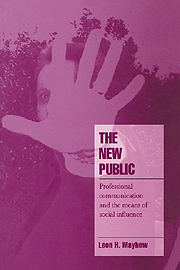Book contents
- Frontmatter
- Contents
- Preface
- Part I Rhetoric and the integration of society
- Part II Influence
- Part III The New Public
- 7 The emergence of the New Public: advertising, market research and public relations
- 8 Political communication in the New Public
- 9 Forums for the redemption of influence
- 10 The rhetoric of presentation
- Notes
- References
- Index
10 - The rhetoric of presentation
Published online by Cambridge University Press: 06 September 2009
- Frontmatter
- Contents
- Preface
- Part I Rhetoric and the integration of society
- Part II Influence
- Part III The New Public
- 7 The emergence of the New Public: advertising, market research and public relations
- 8 Political communication in the New Public
- 9 Forums for the redemption of influence
- 10 The rhetoric of presentation
- Notes
- References
- Index
Summary
Influence is a social phenomenon. It works through appeals to solidarity and is therefore grounded in solidary groups and networks. Accordingly, the structure of influence is a component of the structure of society. On the other hand, rhetoric, the means of creating and activating influence, is cultural; it employs systems of linguistic and visual meaning to evoke solidary attachments. Since the sociocultural contexts of rhetorical practice vary across societies and eras, understanding the rhetoric of a given time and place requires understanding of the cultural assumptions of those who create and consume it, the rhetorical cultures that allow people to make sense of rhetorical appeals and to evaluate their persuasive sway. The variability of rhetorical cultures leads us to a final question about the New Public. Does public communication now operate within the framework of a new rhetoric defined by new norms of persuasion? I argue that it does and I call this new rhetorical culture the rhetoric of presentation, a mode of persuasion that instead of relying on facts and arguments that purport to represent the world, employs direct presentations of stimuli that stand on their own as effective persuaders.
The defining marker of a given type of rhetorical culture is what its participants take to count as legitimately persuasive. In the new rhetoric of presentation, minimal informational content is taken as ideal rhetoric. There has always been a rhetoric of presentation, in which the display of symbols outweighs discursive argument, but the new rhetoric of presentation, developed by media specialists, has produced profoundly anti-discursive techniques that devalue high levels of information as confusing and dangerous.
- Type
- Chapter
- Information
- The New PublicProfessional Communication and the Means of Social Influence, pp. 269 - 286Publisher: Cambridge University PressPrint publication year: 1997



